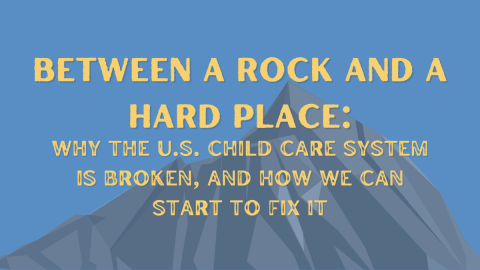
Between a rock and a hard place: Why the US child care system is broken, and how we can start to fix it
Blog by Charlotte Bruce, MPH originally posted on Children's Healthwatch blog.
“I can’t get a job if I can’t afford day care,” Alex explains to a caseworker while bouncing her two-year-old daughter on her lap. “I need a job to prove that I need day care in order to get a job?” she follows up, as the caseworker explains that an application for a child care subsidy would require her to show proof of employment. This early scene from the popular memoir-based Netflix series Maid demonstrates the predicament experienced by parents of young children, disproportionately by women, in the face of an increasingly unaffordable and inaccessible child care and early learning system in the US.
Research highlights the important role child care plays in supporting health, especially for young children at a critical age of brain growth and development. Prior to the pandemic, our research showed nearly a quarter of low-income parents with young children living in 5 US cities reported problems getting child care made it difficult for them to work or study – a condition referred to as child care constraints. Child care constrained families – disproportionately led by Black, Latina, and immigrant mothers – had worse child and parent health outcomes and were more likely to experience difficulty meeting their basic needs (including housing, food, and utilities) than those able to access child care. We know, however, that child care subsidies play an important role in supporting child care access and family health. In our study, families with a child care subsidy were dramatically less likely to experience child care constraints (27 percent compared to 73 percent). Nationwide, however, only one in nine eligible children under age six receive a subsidy due to a lack of federal block grant funding to support all the children who need them. In addition, strict income eligibility and work requirements have excluded millions of additional families in need of this support.
The COVID-19 pandemic further complicated an already inadequate and limited child care and early learning system for families, as some child care providers were forced to temporarily or permanently close. Between December 2019 and March 2021, nine percent of child care centers and 10 percent of family child care providers closed, resulting in the loss of thousands of child care slots and a vital health and work support. In turn, many parents across the country were forced to reduce their working hours or leave the paid workforce entirely to care for their child. This burden disproportionately affected women – particularly women of color – and widened existing gender and racial disparities. In response, Congress provided $39 billion in supplemental funding for the child care sector and $1 billion in emergency funding for Head Start through the American Rescue Plan Act (ARPA), in addition to initial pandemic relief of $10 billion in December 2020. In the year since its passage, this largest-ever investment in child care has reduced costs for struggling families and supported over 150,000 child care providers serving more than five million children, allowing them to keep their doors open and maintain families’ access to critically important services.
ARPA was essential to stabilizing the child care sector and, in turn, families, in the wake of the health and economic fallout of COVID-19. In addition to Child Care Stabilization Grants and supplemental Child Care and Development Fund monies, many families received relief through the expanded Child and Dependent Care Tax Credit – a temporarily increased and fully refundable credit that can offset the cost of child care for families. Nevertheless, the cost and availability of high-quality care remains scarce and unattainable for many. While there is large variation by state and region, a recent report estimates that families across the US pay, on average, $12,352 for center-based infant care and $9,646 for family child care home infant care annually. In 33 states, infant care costs more per year than in-state tuition for four-year public college – for example, in Massachusetts, where the average cost is $20,913. For three- and four-year-olds, the average price of pre-K is similarly high (though not as expensive as infant care), and can take up an outsized portion of families’ budget. The US Department of Health and Human Services defines affordable child care as costing no more than 7 percent of household income for families with low incomes. Comparing national median incomes for households with children, a married couple would need to spend more than 10 percent of their household income and a single parent would need to spend more than 35 percent to afford the average price of care for one child under age five. At the same time, these already overwhelming proportions of household income do not reflect the true cost of providing high-quality care — a difference that providers, many of whom are small business owners, are often forced to make up by seeking private funding, limiting quality, and limiting staff wages and benefits. According to the US Bureau of Labor Statistics, in May 2020 child care workers made an average hourly wage of $12.88 and annual salary of $26,790. These fall far short of a living wage and, ironically, are not enough for child care workers – disproportionately women of color – to afford care for their own children. Such inadequate pay has led to a national shortage of professionals in and returning to the child care workforce, even as demand grows.
Building on the success of ARPA investments and national momentum to address our broken and inaccessible early learning system, Congress must urgently pass legislation that adequately invests in supporting the child care workforce and providing all families with access to high-quality and affordable care of their choice. Without action, the health and stability of families and young children will suffer, and mothers like Alex will continue to face the unsustainable and inequitable trade off of work and child care.
Expanding federal and state funding to subsidize the true cost of high-quality care across settings and establishing a universal pre-K program are critical for the future labor force, economic equity, and health of our children, now and in the future. Solutions are within reach. House-passed legislation providing $450 billion to fund universal preschool and affordable child care – the most significant investment in child care in US history – would enable more than 93 percent of families with children to receive a subsidy for care while simultaneously supporting child care providers and quality of service for all children. This would be transformational for US families and the economy – both of which are constrained and failed by the current system. Congress must act quickly to rectify this situation and pass economic legislation that acknowledges the fundamental role of child care in supporting parents, small business owners and the labor force, and the health and development of generations of children to come.



The views and opinions expressed in this post are those of the author(s) and do not necessarily reflect those of MomsRising.org.
MomsRising.org strongly encourages our readers to post comments in response to blog posts. We value diversity of opinions and perspectives. Our goals for this space are to be educational, thought-provoking, and respectful. So we actively moderate comments and we reserve the right to edit or remove comments that undermine these goals. Thanks!